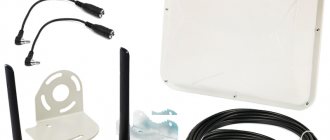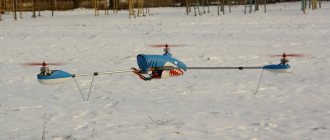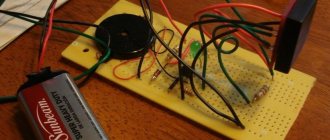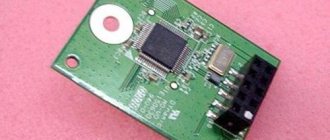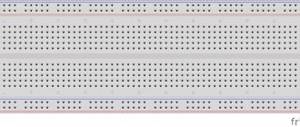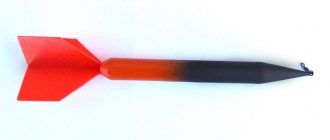Let's review the origins: biquadrat is considered a subspecies of frame antennas, which primarily belong to the zigzag family. Kharchenko Kharchenko was the first to propose the Kharchenko antenna. In 1961 to catch television broadcasts. It is known for certain: at a frequency of 14 MHz, placing the biquadrat in the meadow, an ardent enthusiast managed to reach America. Not a bad result. We believe that the matter concerns refraction, plus diffraction plays out against the Earth. The HF range and below are used due to the ability of waves to refract, bend around obstacles, and it is possible to establish communication over a long distance. Let's go in order. Let's take a closer look at how to make a Kharchenko antenna with your own hands.
Antenna Kharchenko, “eight”, which today catches WiFi, cellular 3G. When installing outdoors, protect the product with a plastic casing.
Communications and antennas Kharchenko
Later it will become obvious: the design of the original Kharchenko antenna, to put it mildly, differs from what is being viewed on the network today. It’s not that they like, as Mayakovsky used to say, to delve into prehistoric g..., but the basics of the theory must be studied in order to avoid mistakes, to know the features of the structure. We are going to tell you how to make a Kharchenko antenna yourself. The author of the monograph avoids giving instructions on the choice of wire thickness, saying: reducing the diameter negatively affects the range. Kharchenko’s homemade antenna is capable of covering digital television in the 470 – 900 MHz spectrum. The characteristics of the device are amazing, the coordination is not very difficult. We'll tell you how to make a Kharchenko antenna, avoiding delving into theory. We recommend that miners study the original thematic edition of the author.
The length of the 14 MHz biquad wire is approximately 21 meters. This is how much cable field you will need to make a simple device. The device is powered by a television coaxial wire (impedance 75 Ohms). Eyewitnesses are sure: Kharchenko’s antenna does not require tuning. The authors are inclined to consider the latter a small (giant size) exaggeration. Think about it! You can plow through the natural landscape by covering your back with two coils of wire:
- skein of vole;
- coil of coaxial television cable.
Then deploy the antenna, the range of which is simply amazing. Polarization depends on which side the figure eight is turned. Let's reluctantly place the number icon, as the number symbol is written in arithmetic textbooks - we will begin to receive television, tilt it to one side, forming infinity - radio broadcasting will begin to be picked up. Since the vole bends well and bends back: if we don’t like one channel, we can quickly orient the antenna to another. The problem is disgusting: the excess wire, which is unnecessary for useful needs, will have to be either cut off or coiled, placed in such a way that it does not interfere with reception. And this is not such a trivial task as it seems to the first person you meet:
- if you put it horizontally, it will pick up television;
- if you stretch it to the ground, the intermediate wire will begin to take on vertical polarization;
- hang it on a branch - vertical polarization will be caught.
No matter which way you turn the extra cable, no matter how you lay it, interference is guaranteed. Check the azimuths, try to find the angle of arrival of the broadcast. If there is only one direction, we wrap a long stick with wire and place it perpendicular to the line of sight to the station, minimizing the parasitic effect to zero.
Double square antenna
The “double square” antenna provides signal amplification when working with distant correspondents up to 10 dB (ten times the power), although the width of its radiation pattern in the horizontal plane is slightly larger than that of a three-element “wave channel” antenna.
This is explained by a narrower radiation pattern in the vertical plane located at a small angle to the horizon.
This antenna does not have to be raised too high - the optimal height of its center above the underlying surface is 0.5-0.75 λ. The attenuation outside the main lobe of the radiation pattern of this antenna is slightly worse than that of a three-element “wave channel”, and amounts to 15-20 dB (2.5-3.5 volume points).
Rice. 1. Double square antenna
The “double square” antenna consists of two elements - an active one and a reflector (Fig. 1).
Both elements are made of copper cord with a diameter of 3-4 mm.
From below, a coaxial cable with a characteristic impedance of 75 Ohms is connected to the active element gap, and an open two-wire line (which is practically a continuation of the reflector frame) with a distance between the wires of 150-200 mm and an adjustment jumper sliding along it is connected to the reflector gap.
The spacers on which the antenna elements are stretched are best made of insulating material (ideally fiberglass, but bamboo and pine slats can also be used). Satisfactory results are obtained with spacers made of duralumin pipes with insulators at the ends. In this case, the vertical spacers are made of solid pipes, and the horizontal ones are separated by insulating inserts (fiberglass, fluoroplastic reinforced with a steel rod, etc.), so that each of the four horizontal spacers (two each for the active element and the reflector) consists of three approximately equal isolated parts.
Recommended antenna dimensions are given in table.
Adjusting (tuning) the “double square” antenna involves changing the length of the line that tunes the reflector. To do this, the antenna must be turned with a reflector towards a source of a powerful signal with horizontal polarization, the distance from which to the antenna is at least 10 λ.
Having connected a transceiver operating in receive mode to the cable output, you need to adjust the position of the jumper to the minimum readings of the S-meter. After this, you need to check the SWR in the cable: its value should not be worse than 2 with a minimum near the center of the range.
If this minimum is greatly shifted, you will have to change the total length of the active element and repeat the reflector adjustment.
PS Reviews about the antenna are only good - the effect of a breakthrough antenna during DX QSO was constantly noted, which pleased the owner of the “double square” antenna for many years.
From the book UA1FA
Up 73!
Antennas
One of the best directional antennas is the “ Double Square ” antenna, which is rightly dubbed the “Queen of DX ”. Like all “wire” antennas, it is easy to make on your own and does not require expensive materials. Double Square ” CB antennas When calculating it, we used information gleaned from K. Rothhammel’s book “ Antennas ,” widely known to radio amateurs. Specifications:
— gain relative to a “GP” antenna with a length of 5/8 λ — 8-9 dB, — frequency band (at SWR level = 1.6) — from 26,600 to 27,900 MHz, — polarization — vertical, — gain ratio in forward-backward directions - more than 20 d6.
A comparison of the characteristics of the GP 5/8 λ antenna and the described antenna was carried out when communicating at a distance of 50 km, i.e. at small radiation angles relative to the horizon, which is most important for long-distance communications by surface waves. The antenna design is shown in Fig. 1
. The 220 cm long crossbar is made of two steel pipes with a diameter of 30 and 24 mm with a wall thickness of 3 mm. One pipe slides into another for ease of transportation. When the pipes are assembled, the traverses are fastened with through bolts. At the ends of the traverse crosspieces are welded from sections of two-inch pipe. To attach it to the mast, a steel cup with a diameter of 60 mm and a length of 25 cm is welded in the middle of the traverse. Antenna spacers (8 pieces) 190 cm long were made from round hazel sticks. At the ends of the spacers, pieces of plastic tube 10 cm long are tightly fitted with holes at the ends through which the cord is passed. The spacers themselves are secured to the crosspieces using clamping screws. A cord made of cable braid with a diameter of about 3 mm was used.
Fig. 1 The length of the vibrator cord (including the cable) is 11 m 2 cm. The length of the reflector cord (including the cable) is 11 m 30 cm. It is recommended to provide some reserve length of the cord, which can be removed after setting up the antenna. The 50 ohm power cable is connected to the middle of the side of the vibrator. The distance between the connection points of the central core and the cable braid was 7 cm. Structurally, the vibrator power supply unit was made in the form of a plastic box filled with sealant to protect the cable termination site from precipitation. From the vibrator the cable runs horizontally to the crosspiece, then along the traverse to the mast and then down along the mast. The adjustment cables have lengths: for the vibrator - 10 cm, for the reflector - 50 cm. The jumpers were attached by twisting during adjustment, and after the adjustment was completed, they were soldered. The setup begins with the vibrator. By adjusting the length of the loop, we achieve a minimum SWR at the middle frequency of the range. The length of the reflector cable is adjusted to achieve maximum antenna gain. To do this, any generator is placed as far as possible in front of the antenna (no closer than 20 m), a receiver with an S-meter is connected to the cable output and maximum readings are achieved. There is positive experience in constructing antennas of this type based on a supporting structure made entirely of wood. This significantly reduces its weight, which makes it easier to lift onto the mast; in addition, a lighter antenna is easier to make rotating. When making a structure from wood, measures should be taken to protect it from atmospheric influences. It is recommended to coat the supporting beam and crosspieces with hot drying oil or floor varnish. Some radio amateurs wrap the entire wooden structure with a bandage soaked in nitro varnish or nitro paint. This makes the structure somewhat heavier, but makes it more durable. In this case, you can use ordinary pine slats. This antenna , like all antennas, is a “toy of the wind”, so all screw connections must be made using spring washers to avoid them becoming loose. All threaded connections must be protected from corrosion with window putty or plasticine. The antenna design is shown in Fig. 2
.
Figure 3
shows the design of the attachment points for the traverse to the mast and the supports for the traverse.
Fig.2 Fig.3
The plates can be made from duralumin, textolite, plywood, i.e.
any materials that provide the necessary mechanical strength. The wire from which the vibrator and director are made can be copper, with a diameter of 1.0 - 2.0 mm. Even better is to use an antenna cable. To attach vibrators to supports, you can use porcelain insulator rollers, which are secured with screws to the support rails. The vibrator and reflector of the antenna are adjusted using cables, so it is necessary to provide for the possibility of attaching the cables to supports, for example, as shown in Fig. 4
.
Fig.4
For channel 20 of grid C, i.e. for a frequency of 27.200 MHz, the length of the vibrator wire is 11.1 m. One side of the square is 2.77 m. The length of one vibrator support is equal to 1.96 m. The length of the traverse should be 0.2 λ, which gives a size of 2.22 m. The length of the reflector wire should be slightly longer, which is ensured by choosing the length of the cable during setup. It is recommended to select the length of the tuning cables in the range of 0.7 - 0.8 m, and the distance between the wires of the cables is 5-15 cm.
Fig.5
Figure
5
shows the electrical circuit of the antenna.
The described antenna has vertical polarization, its expected gain is 8-11 dB. To obtain the calculated radiation pattern, the antenna feed point must be located at a height greater than or equal to half the wavelength (i.e. 5.5 m) from the ground. To obtain horizontal polarization, it is necessary to power the “ square ” not from the side, but from the lower or upper vertex. All other dimensions are preserved. In this case, even closely spaced vertical metal masts will not greatly distort its diagram. If it is possible to stretch a horizontal nylon cord in the direction of the correspondent at a height of more than 6 m, a “ double square ” can be made without spacers by hanging the tops of the frames to the cord and stretching the conductors of the frames with nylon cords or fishing line.
Top
